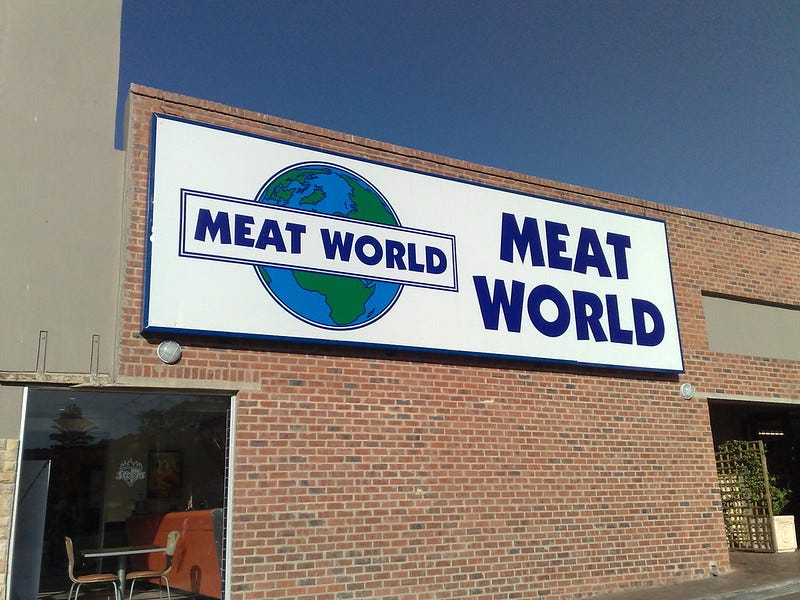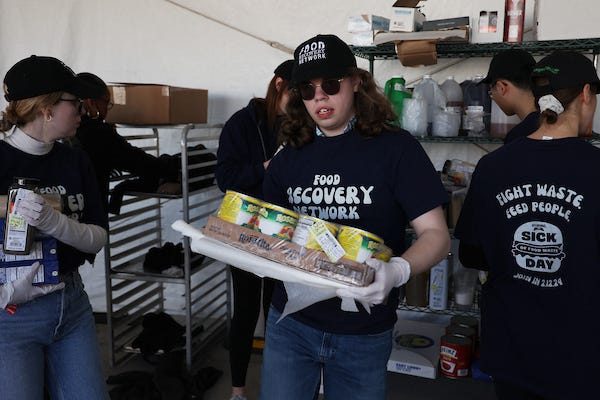Alt-food reality
What I talk about when I talk about faux chocolate, opinions on cultured meat, and how to recover food from a tailgate party.
My happy place is knowing I have at least three bars of chocolate in my pantry. Dark chocolate with a high cocoa percentage is my front runner but I enjoy dabbling in the lesser. I spend way too much on my habit but it’s cheaper than my former addiction. Shoes.
Maybe you’ve read that cocoa prices are soaring due to extreme weather conditions? I can’t say I planned this, but the headlines coincided with an article I wrote for the San Francisco Chronicle. In it, Voyage Foods, based in West Oakland, makes a “chocolate” replacement as an ingredient to be formulated into snacks and candies. This new alt-chocolate is made from a blend of seeds, sugar and palm oil. The startup believes that commodity chocolate, like what’s used in M&Ms and Snickers, can and should be subbed out for alternatives that can withstand the world's pressing climate issues.
Chocolate was going to be today’s topic, but I’ve got bigger nuts to crack.
There was an opinion piece this week about cultivated meat in the New York Times. The writer suggests the industry is faili. He wrote: “It is increasingly clear that a broader cultivated meat revolution was never a real prospect, and definitely not within the few years we have left to avert climate catastrophe.”

Is climate catastrophe only a few years away? Well, it depends on how we define catastrophe. I’m fairly dejected by how we’re living and treating the planet, but a few years out seems a bit hair-on-fire.
If you want to find hope for the climate, get a copy of “Not the End of the World” by Hannah Ritchie, a climate scientist at Our World in Data. Her book counters the “over dramatic worldview” we get from the media with phrases like the one above and the near constant stories that make us think climate change is only negative with little in the way of improvement. Ritchie’s very optimistic, which I appreciate and she offers ways we can get involved. On farming, she makes it simple: “improve crop yields around the world, eat less meat, invest in meat substitutes, replace dairy with plant-based alternatives, and waste less food.”
Ah, waste less (YES), but back to cultured meat. The opinion piece veers from traditional Op-Eds and spills too much tea on a lengthy re-hashing of the minutiae of the leading companies – Upside Foods and Eat Just. The ones with US regulatory approval for cell-based chicken. There’s also an Israeli company (Aleph Farms) that has recent approval in its home country for beef. But there are at least 80-90 other companies that are quietly doing work with little to no press. What of them?
This is the Beyond Meat problem. Because Beyond is publicly traded it means that any hiccup is reported over and over as signs of the plant-based sector’s failure. Plant-based proteins, or alternative proteins, are here to stay and with time they will evolve and get better. Eventually we’ll have more options that are as strong as tofu, tempeh, beans and legumes. Because Upside and Just have been so vocal, every step is watched over as a gauge for what’s to come. That these two have gone out big and then dialed it back is important to notice, but it doesn’t mean the idea is going away.
My favorite sentence in the essay comes from a recent conference in which an expert notes that, “R.&D. will go back into academia.” It’s true, but it’s already there and it's funded by state budgets, government agencies and New Harvest, to name a few. Maybe he means it needs to come out of the private sector entirely until universities prove a route that works? That’s where cultured meat started – a lab in Long Island, using grant money from NASA, grew goldfish cells as a possibility for astronaut food. In the end they determined it was too much work.
Yes, growing meat this way, microscopic cells in a lab nurtured along by costly medium and engineers, is too much work. Is there another way? Yes. Have we found it yet? Maybe.
Synthetic biology startups raised a ton of money ($3 billion or so to date) to make meat for a world that doesn’t yet want to stop eating meat – or even eat less. Once startups raise money, investors want them to spend it. They want milestones achieved. In Technically Food, I point out the complexity of going from lab scale to mass adoption in too few steps. It’s not going to work. Today’s cultured meat is essentially an artisan product, but these startups aren’t taking their product to the farmers markets. They’re taking it to Michelin-star chefs and then Walmart.
Slow down, write smaller checks, find new ways of thinking, collaborate, work with nature not against it. The human diet depends on protein, yes, but we need more options not less. I hope to see more ingenuity come from plants but I don’t want to ignore that there might be a way towards meat.
Cultivated meat, the writer declares, “was an embodiment of the wish that we can change everything without changing anything. We wouldn’t need to rethink our relationship to Big Macs and bacon. We could go on believing that the world would always be the way we’ve known it.”
I don’t think anyone believes they live in an unchanging world, but whether we can accept that it’s our minds that need to change before our diet is the question. Can we accept a Snickers bar coated in something that doesn’t have cocoa in it? As long as it’s delicious the answer is certainly yes.
Other tidbits:
Upside Foods halts progress (what little had been made) on building a giant cultured meat facility in Chicago. Right now it’s just a big hole in the ground.
Another Superbowl, another giant event with too much food. I covered the Food Recovery Network – a student-run food waste non-profit – in my newsletter last February. FRN did it again last weekend at a Superbowl tailgate party in Las Vegas. Some stats from the event: FRN recovered 3,994 pounds of food---an equivalent of 3,328 meals---that it donated to The Just One Project. This is nearly half a ton more food than recovered last year. One reason for the excessive excess could be that as Covid recedes further in our past, more people are going out. More people, more to order and prep for, more waste. Erin Price, the director of engagement at FRN was surprised this year to see rare foods like foie gras, oysters, and ground lamb. (I am too!) Big events seem like the perfect thing for AI to solve. What to to order, how much to have on hand and what to do with the excess quickly. I look forward to that day.
Where you can find me:
On the front page of the San Francisco Chronicle.
Is our junk-food addiction killing us? Watch my Cambridge Forum episode with Jerry Mande and Tera Fazzino.
What I’m reading:
Too much! “The Last Island” (nonfiction) about an island inhabited by a tribe of people who have zero contact with the outside world. “Killers of the Flower Moon,” (nonfiction) which I started last night. I’ll let you know how it’s different (or better?) than the movie. I’ve got “The Nix” (fiction) in the wings waiting for me. Also my usual New Yorker’s and Harper’s Magazine.
A reminder: I send my newsletter out every other Friday and once a month I send a special edition to paid subscribers. It will only set you back one fancy coffee a month. Consider supporting me below.



